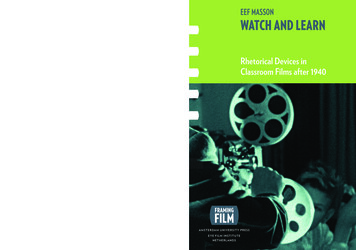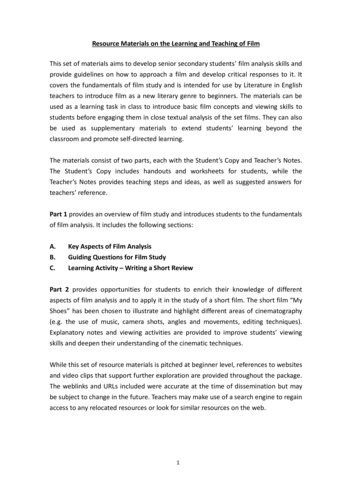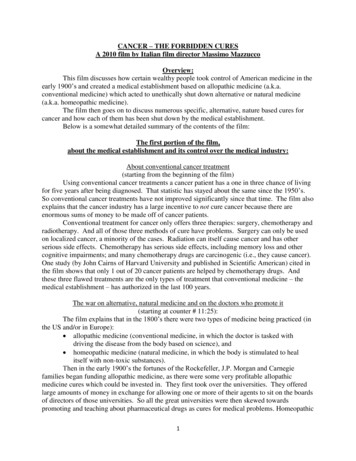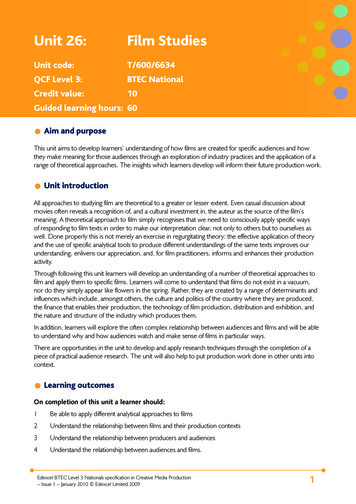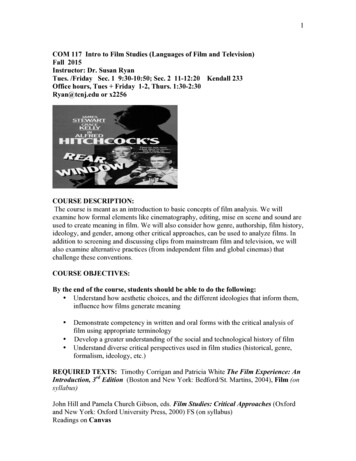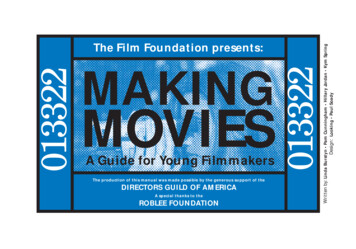
Transcription
MOVIESA Guide for Young FilmmakersThe production of this manual was made possible by the generous support of theDIRECTORS GUILD OF AMERICAA special thanks to theROBLEE FOUNDATIONWritten by: Linda Burstyn Pam Cunningham Hillary Jordan Kym SpringDesign: Looking Paul SoadyMAKING013322013322The Film Foundation presents:
Table of ContentsIntroduction . . . . . . . . . . . . . . . . . . . . . . . . . . . . 1 Chapter 4: Production Cast and CrewA Word from Your Sponsor. . . . . . . . . . . . . . . . 2 Art Production. . . . . . . . . . . . . . . . . . . . . . . . . . 53Preface: What Is a Movie? . . . . . . . . . . . . . . . . . 4 Acting. . . . . . . . . . . . . . . . . . . . . . . . . . . . . . . . . 55Costumes and Makeup . . . . . . . . . . . . . . . . . . 59Explore: Continuity . . . . . . . . . . . . . . . . . . . . . 67Chapter 1: StorytellingOther Important Responsibilities/Jobs . . . . . 66Making Movies Is about Telling aStory.Visually . . . . . . . . . . . . . . . . . . . . . . . . 5 The Camera . . . . . . . . . . . . . . . . . . . . . . . . . . . 68Words or No Words . . . . . . . . . . . . . . . . . . . . . . 6 Lighting: a Bright Subject . . . . . . . . . . . . . . . 80Words, Words, Words. . . . . . . . . . . . . . . . . . . . 10 Sound . . . . . . . . . . . . . . . . . . . . . . . . . . . . . . . . 82Making It Better: with Problems . . . . . . . . . . . 12Tips from the Experts . . . . . . . . . . . . . . . . . . . . 14 Chapter 5: EditingPutting the Puzzle Together . . . . . . . . . . . . . . 87Explore: Creating an Editing Storyboard . . . . 94Chapter 2: From Story to ScreenplayScriptwriting . . . . . . . . . . . . . . . . . . . . . . . . . . . 15 Technical Aspects of Video Editing . . . . . . . . 97What’s Your Story? . . . . . . . . . . . . . . . . . . . . . . 18Writing Your Screenplay, Finally! . . . . . . . . . . 26 Chapter 6: Making Your MovieTips from the Experts . . . . . . . . . . . . . . . . . . . . 31 Your Production Schedule . . . . . . . . . . . . . . . 101Sample Screenplay . . . . . . . . . . . . . . . . . . . . . . 32 Note to the Director: A WordNote to the Director . . . . . . . . . . . . . . . . . . . . . 37about Continuity . . . . . . . . . . . . . . . . . . . 107Moviemaking Roles . . . . . . . . . . . . . . . . . . . . . 38 Production! Shooting Your Movie. . . . . . . . . 108The Editing Process . . . . . . . . . . . . . . . . . . . . 114Forms and Contracts . . . . . . . . . . . . . . . . . . . . 115Chapter 3: DirectingGetting the Picture: Directing . . . . . . . . . . . . . 39Creating a Storyboard . . . . . . . . . . . . . . . . . . . 42 Epilogue: Looking Back . . . . . . . . . . . . . . . . . 118Checking Your Shots.Beforehand. . . . . . . . . 49 Glossary. . . . . . . . . . . . . . . . . . . . . . . . . . . . . . 120Working with Actors . . . . . . . . . . . . . . . . . . . . 50 Directors Guild of America . . . . . . . . . . . . . . 124Directing Tips from the Experts . . . . . . . . . . . 52 The Film Foundation . . . . . . . . . . . . . . . . . . . 125Roll Credits . . . . . . . . . . . . . . . . . . . . . . . . . . . 126
IntroductionThe Mask of ZorroPhoto: Ron BatzdorffCopyright 1998 Columbia Pictures Industries, Inc.All Rights Reserved.Dr. Seuss’ How the Grinch Stole ChristmasThe Grinch (Jim Carrey) conspires with his dogMax to deprive the Who’s of their favorite holiday.Copyright 2001 Universal City Studios, Inc.Courtesy of Universal Studios Publishing Rights,a Division of Universal Studios Licensing, Inc.All Rights Reserved.1This manual will help you make a movie.It is written like a basic recipe for chocolate; itgives you the basic ingredients and lays out theprocess. Whether you make fudge or M & M’s isyour challenge. As a filmmaker, you also have achallenge: to tell your story with your vision,using your creativity and intelligence. Whetheryou are ambitiously learning how to make amovie on your own, or working with others in amoviemaking group or class, enjoy. Enjoy theflexibility and discover the fantastic foibles offilmmaking.This guide explains the basics of making alow-budget, student film. It’s a big contrast toHollywood, but the talents and skills needed tomake a good film are the same.In Hollywood, hundreds of people oftenwork on a single film. You might work togetherwith just eight friends but the process remainsthe same.On a big Hollywood production, there aremany specific jobs. If you watch the credits at theend of a major movie, you will see that there is adirector (who is in charge of the entire movie),actors, at least one writer, a cinematographer, aproducer, an executive producer, an associateproducer, editors, art directors, and sound-effectspeople. One person operates the camera, oneperson is in charge of moving the camera, andstill another might be in charge of making surenothing gets in the way of the camera. There arealso dialogue coaches, stunt coordinators, gripsand gaffers, makeup artists, assistant makeupartists, costume specialists, and assistantcostume specialists. These are just a few of thoseinvolved in a big Hollywood movie.Fortunately, you do not need all thesepeople to make a film. In making a short film,each person has a special role to play, and eachwill probably have multiple jobs in order toaccomplish all the aspects of film production.This guide introduces these differentcomponents. Everyone has something special to offerin making a movie. This is about learning, having fun, andexploring your creativity.Just like athletes must practice to buildtheir strength, coordination and skill, thismanual offers experiments, or explorations towork your moviemaking muscles. Some mightbe as boring as lifting weights. Others might beas fun as a pick-up game of basketball. Together,they will help give you the skills and experiencesneeded to direct and make a movie. You have toprovide the creativity.
A Word from Your SponsorDo you like going to the movies?Did you ever want to create a movieof your own?Maybe you like working with cameras and lights. Perhapsdesigns, colors and costumes fascinate you. Maybe you like tocompose and perform music. The film industry includes people withall kinds of talents and interests—from directors, actors, writers andcinematographers to art directors and sound engineers. In fact, film isthe only creative process where people from many differentbackgrounds work together to produce a single work of art called thedirector’s vision.Now imagine this: The film you created—or helped to create—isdeteriorating. The moving images are fading to black. The soundtrackis distorted. With each passing year, the chemicals on the film tapedecay a little bit more until one day the film is simply no longer there.Once a film self-destructs, no one can ever view it again.How would you feel if all your hard work and creativity haddisintegrated to dust?What is film preservation and why does it matter?Hundreds of movies made in the 20th century—the first centuryever to use moving image technology—have already self-destructed.2“So what?” you might ask. So what if 50 % of the movies madebefore 1950 are lost. What does it matter if a movie made in the yearyou were born has begun to fade? Movies are just entertainment,after all, aren’t they?Many people—both filmmakers and movie-goers alike—wouldnot agree. Movies matter—and here’s why.Some movies record history, capturing current events andcommunity and family traditions. With moving image technology,we can hear and see Reverend King deliver his “I have a dream . . .”speech on the steps of the Lincoln Memorial in our nation’s capitol.We can watch Neil Armstrong take humankind’s first step onthe moon.Other movies reflect history. These movies comment oncurrent events and traditions. For example, in TO KILL AMOCKINGBIRD (1962, dir. Robert Mulligan), Gregory Peck portraysan Alabama lawyer in the 1930s. He argues his case in a segregatedcourtroom where African Americans must—by law—sit in thebalcony.Some movies imagine the future. In THE DAY THE EARTHSTOOD STILL (1951, dir. Robert Wise), movie-goers of 1950swatched in awe as a flying saucer landed on Earth. The alien hadcome with a warning: If Earthings did not end war and learn to solvetheir differences peacefully, they would face total destruction.
Movies matter because they are more than images and sounds.They are stories. The stories movies tell have a value beyond making uslaugh or cry or hold our breath in suspense. They provide clues tounderstanding who we are . . . or were. Movies mirror our hopes andfears, our achievements and failures. Like a painting, a symphony or anovel, movies an important source of artistic and cultural informationabout our country.Movies matter, also, because they can be great teachers. Thinkabout it. How does a young artist learn to paint or sculpt? By studyingthe works of the great masters. Likewise, musicians might studyBeethoven or the Beatles. To learn their craft and seek inspiration,young writers may read Shakespeare, Austin, or even Harry Potter’screator, J. K. Rowling.But, if the great films of the past are lost (as many already are)who will the young filmmakers of tomorrow study?Because movies matter, the United States Congress passed in1998 the National Film Preservation Act. Preservation means toprotect films from deterioration as well as to restore decaying filmbefore images and sounds are lost forever.Because movies matter, some of the most famous directors in thefilm industry created The Film Foundation. The foundation’s goal is toincrease awareness of this country’s film heritage and to preserve asmany films as we can. The first step in saving movies is understandingthat movies are more than entertainment.3The Film Foundation created this manual for you. We createdthis manual because we believe:n viewing and/or making movies can be an exciting andcreative learning experience for all youth;n understanding the decisions, hard work, and passionrequired to make a movie will help you better understandwhy films are worth saving.Get ready. The pages inside this manual are filled with allkinds of creative activities. Some will challenge your critical thinkingskills. Some will inspire you to communicate with others as younever have before—using images and sound as well as words.Whether a movie-goer or a future filmmaker, you can be sure thatthe movies that matter to you, matter to us all.
Preface: What Is a Movie?Photo: Phil BrayThe word “movie” comes from the term “motionpicture” — pictures that move.Mrs. DoubtfireRobin Williams is Mrs. Doubtfire.Copyright 1993 Twentieth Century Fox Film CorporationAll Rights Reserved.BeetlejuiceBarbara and Adam Maitland (Geena Davis andAlec Baldwin) change their minds about usingthe skills of demonic “freelance bio-exorcist”Betelgeuse (Michael Keaton) when he showsthem his scary stuff.Copyright 1988 The Geffen Film CompanyAll Rights Reserved.4Like books, movies tell a story. But insteadof words on paper, movies are a visual and alistening experience. The audience sees andhears the story. People all over the world love thispowerful medium — they love the way moviestell stories.The storyteller is the director. He/she is incharge of how a story is made into a film. Exactlywhere and how the images are filmed and edited,how the actors portray their characters, and whatthe audience experiences, is all part of thedirector’s vision. The story itself can be simple orcomplex, silly or intense. The director’s vision isresponsible for how the movie makes theaudience feel about the story: sad, amused,bored, exhilarated, scared, powerful, or humble.Stories in books can describe any place inthe universe, with any number of characters. Butthere are constraints in filmmaking. Filmdirectors can be limited by the weather, numberof actors, available space, and, especially, themoney needed for props, costumes, speciallighting, sound and camera equipment. So, a lotof creative problem-solving comes into play.It is the director’s challenge to make his orher vision translate from story to movie, usingthe techniques of filmmaking — things likecharacter development, camera angles, andediting. But you have to develop your ownvision and probably the best way is to create (orhelp create) a film from beginning to end. Bydoing so, you will learn how to: develop a story and interesting characters write the story in the language offilmmakers: a screenplay create a visual storyboard to show cameraangles, distance, and subjects plan a filming schedule utilize various camera, sound, and lightingtechniques work with actors understand the power of art direction andcontinuity use costumes and makeup do post-production sound and editingThese components are presented in this manualfor you to learn, practice, and adapt to fit yourown vision. Throughout this manual, movies willbe recommended as prime examples of differenttechniques and film accomplishments. Don’tworry if you can’t see every movie. You canobserve and analyze the concepts in many films.
“ The learning process is never over. Every new work creates new sets of problems thatneed immediate answers. And there are certain answers you can only find in theworks of the great masters To find your own voice doesn’t mean you have to be deafto other voices. Sometimes they work as an echo, other times like a series of trafficsigns that, if right, will guide you to create a work that will touch other people.”—Martin ScorseseDirector, The Age of InnocenceChapterStorytelling Making Movies Is about Telling a Story.Visually Words or No Words Words, Words, Words Making it Better: with Problems Tips from the Experts1
STORYTELLINGMaking movies is about telling a story.visuallyA Movie to WatchAlmost every movie tells a story and the betteryou are at storytelling, the better you will be atmoviemaking.Star Wars: A New Hope,directed byGeorge Lucas.One of the classic ways to tell a story is tofollow this simple story formula: There is a hero. Hero faces a scary or difficult adventure orproblem. He/she is trying to accomplishsomething. Hero eventually overcomes his/her fear andgoes on the adventure. Hero faces serious obstacles. Hero solves his/her problems, andovercomes the obstacles. Hero reaches his/her goal and learns a lotalong the way.This, the first of theStar Wars movies, reallyfollows a hero’s journey.By combining a simple storywith special visual effects,Lucas created an epic film.Watch it to see how well it followsthe story formula.5This formula may sound basic, but hugenumbers of excellent movies have used it.The power of a film comes more from howthe story is told.You can read more about this formula in TheWriter’s Journey by Christopher Vogler.Telling a story in a movie differs from usingwords to write a story. This chapter will tell youabout those differences and give you exercisesto help you become a better storyteller and moviemaker.
WORDS OR NO WORDSSometimes, movies don’t use words to tell the story.Watching a movie is a visual experience.Much of the story is shown to the viewerwithout using any words. Think about amovie that opens with a car chase, or a dog’sview of the sidewalk as it is being walked.No words are used (in movies, the words arecalled dialogue), only visual images andsounds: cars crashing, the jingle of a dogleash, or sometimes, just music.Imagine a scene in a horror film where amonster sneaks up on his victim, ready topounce, and, at the last minute, the victimturns around and screams. Again, there isno dialogue; the director wants the audienceto see the action, to feel more captivatedand scared.Now, imagine the opposite:Monster “I am now approaching my victim,ready to pounce.”Victim “And here I am, completely unaware ofwhat’s about to happen.”Monster “Here I go, about to jump!”Victim “I think I sense something comingtowards me uh-oh!”6This dialogue would be silly, and funnyinstead of scary.In filmmaking, the storytellers decide if thefeeling expressed to the audience would becommunicated better without using words.In our daily lives, we experience non-verbal(no words) communication all the time. Thinkabout when your mother, or father, or bestfriend gets mad at you. Sometimes the waythey look at you, or the things they do likeignoring you or turning their back on you canbe more hurtful than anything they might say.How can you tell people how you are feelingwithout using words?List three ways you can communicate yourfeelings non-verbally:Have you ever been around someone who isspeaking a foreign language? Could you tellsomething about what they were saying justfrom their tone of voice, gestures, andemotions? People can communicate withoutsaying, or understanding words. Many times,you see the true character “underneath” thewords. Actors work hard to show the audiencethe true nature of their characters, using morethan just words.Can you tell by someone’s body language ifthey are surprised? How can you tell?Describe what someone might do with theirface, or other body parts, to convince anaudience they are really:grossed out by a cockroach.12disappointed by a bad grade on a test.3shocked to hear an old lady swear.
EXPLORE:After you do this exercise, record some of your thoughts:acting without wordsIt was easy to actYou need at least one other personfor this exploration. It’s a little likecharades. Write down as manyemotions as you can think of, likesadness, pleasure, anger, fear,surprise, embarrassment, and shynesson individual slips of paper. Fold upthe pieces of paper and put them ina hat or a bowl. One person picks apiece of paper and acts out theemotion without saying a word. Theother person(s) guesses the emotion.However, some emotions are prettyhard to act out.becauseIt was hard to guess that my friend was trying to actbecauseI had an easy time guessing that my friend had pickedbecause7
EXPLORE:Pick one movie where the emotion of a character was communicated very effectivelywithout dialogue:How do directors conveythe feelings of the characterswithout using dialogue?Movie:Name of character:Compare two movies. Look fortechniques like the angle anddistance of the camera, the actor’sbody language, the sound effects,and lighting techniques.Give an example of how the director and actor revealed the character’s emotion in aparticularly powerful scene:How did the music or other sound communicate the way the character was feeling?Did you think about whether the director decided to use a particular angle of the camera,or if the lighting helped communicate emotions?Ideas:8
Now choose the opposite — a scene in a movie that did a poor job of expressing feeling.Movie:A Movie to WatchBlack Stallion,directed byCarroll Ballard.Name of character:This is a great moviethat tells a dramaticstory without a lot ofdialogue. You should alsowatch a silent movie, likeThe Kid, directed by CharlieChaplin. Made in 1921, it is awonderful example of howmoviemakers were able to tellstories even before they knew howto make sound in movies.How was this character’s emotion shown?Obviously, it often makes sense for characters to talk. But it is important torealize that in film, dialogue is just one technique used to convey the movie’sstory. Filmmakers-in-training should experiment with all the techniquesintroduced in this guide.9
WORDS, WORDS, WORDSMovies usually include dialogue to help tell the story. EXPLORE:how real people talkHow do people talk to each other?How do people look as they arelistening to someone?How do people combine words,expressions, and other types of bodylanguage during conversation?In order to make a movie, you will probablytell your story using action without dialogue,as well as with dialogue. It is important tounderstand how to express parts of the storyusing only action and images, and to practicewriting dialogue. There are no rules, but thefilms that many people respond to usedialogue that seems real — how a real personwould talk.Take a field trip for this exploration.Go to a public place, like a restaurant or amall, and observe the different ways peoplecommunicate. Pay attention to theconversations around you. Notice the types ofwords, accents, phrases, and topics discussed,and how the people interact whencommunicating back and forth. Do they pausea lot? Do they talk really fast? Does the personthey are talking to seem to understand thembetter than you?Amusing phrases or words:Strange phrases or words:Other observations:Public place:“Characters”:10You may want to keep notes about otherinteresting people you observe, to give youideas later for developing the characters inyour film.
EXPLORE:DEMAUNE: Good thing we caught the bus.Write a conversationCHRISTINA:The characters are Demaune andChristina, and they are your age.Here is the scene: Demaune andChristina barely made it on theschool bus, and had to sit together.Both are embarrassed. They likeeach other, but neither one wantsthe other to know. Christina iswondering if Demaune knowsabout Renee’s party this weekend,but she does not know how to askhim. In the first line, Demaune says:“Good thing we caught the bus.”oTips from the Experts When writing dialogue, think about howpeople really speak. You do not want the characters to soundlike they are giving a speech. Have them talk the way you know peopletalk. If they speak in slang, use it.11 Be sure to read the dialogue out loud. Listen to how it sounds. If it soundsnatural, keep it. If it sounds strange, or forced, rewrite it.
MAKING IT BETTER:WITH PROBLEMSSome stories are great. As you are reading orwatching them, you cannot wait to find outwhat happens next. Other stories are boring,and put you to sleep. How do you tell a storyto make it exciting?Storytellers often make their stories moreinteresting by adding conflict. The conflict canbe a battle or a contest of some kind. EXPLORE:Sometimes, conflict is created when oneperson wants to do something, and someoneelse is trying to stop him or her from doing it.Conflict can also come from within thecharacter. For example, a woman wants a raisein salary. She totally deserves the raise, but sheis insecure and afraid to ask her boss. Theconflict here comes from within the woman— from her own fear.Question: How can you make a story moreinteresting, more dramatic?Answer: Create an obstacle — create conflict,create a problem.What is one of your favorite movies?Did the hero face an obstacle? What was it?Who was the hero of that movie?How did the hero overcome the obstacle?Obstacles are more dramatic if they are alive.Climbing a mountain can be an obstacle, butit might be more dramatic if someone tries toprevent you from climbing to the top.the use of obstaclesDo obstacles really make stories moreexciting? Think about and answer thesequestions:12
EXPLORE:Character Barry, age 15, has decided he has to quit hanging out with his friends, because theyhave started committing hate crimes against gays, African Americans, and Asians.creating obstaclesObstacles:Below are four characters. You createthe obstacles/conflict for each one.Try to give them human obstacles someone who wants the opposite ofwhat Barry, Shartelle, Quintin, andJuan want.Character Shartelle, age 24, wants to move from New York City to her aunt’s farm in NorthernMichigan. She is trying to break away from a life of using drugs and get her life back together.Obstacles:A Movie to WatchCharacter Quintin, age 19, wants to follow his passion to become a biologist and help saveendangered species. But his mother, a single parent, thinks making money is the mostimportant priority, and will not pay for his college unless he goes to Business School.Titanic, directed byJames Cameron.Obstacles:The main character,Rose, has severalconflicts — herrelationship with herill-suited fiancée, theexpectations of hermother and wealthy socialgroup, not to mention, trying tosurvive the sinking of the Titanic.This movie is an excellent exampleof how conflicts and obstacles canintertwine.Character Juan, age 13, has grown up in Kansas and he’s never left the state. He wants morethan anything to go mountain climbing. By helping his dad with his business, collecting oldtires to be recycled, he has saved enough money for a plane ticket.Obstacles:13
oTips from the Experts Stories are most interesting when thecharacters have big decisions to make,and when the audience knows thatmaking the wrong decision would be areal disaster. Stories are most dramatic when theconflicts are intense and require thehero to make hard decisions. The audience should understand thegoals of both the hero and the personA Movie to WatchThe Truman Show,directed byPeter Weir.This is an originalstory of TrumanBurbank, a man whoselife is nationallytelevised, unbeknownstto him. Truman slowly uncoversthat all the people in his life are“actors,” and his reality, as he knowsit, doesn’t actually exist. It’s awonderful film with heartwarmingscenes, clever dialogue, and a freshand innovative plot.A must see!Notes:14(or monster or animal) trying to blockthe hero. The audience might evenlike both of them. Stories can be exciting when bothsides have a good argument and it ishard for the audience to decide who isright. There should be plenty of surprises.
“Write, write, write, and write again.”—Spike LeeDirector, Do The Right ThingChapterFrom Storyto Screenplay Scriptwriting What’s Your Story? Writing Your Screenplay, Finally! Tips from the Experts Sample Screenplay Note to the Director Moviemaking Roles2
SCRIPTWRITINGThere is a critical step in taking a story idea and making it into a movie.It is a particular format that goes by two names — screenplay or script.All movies need a script. In a screenplay, the dialogue is written aparticular way, and descriptions of settings and action are abbreviated.SCRIPT EXAMPLE: Half NakedTwo guys are standing in an empty, school hallway, wearingnothing but underwear. They have been pushed out of thegym locker room. Delmont tries to get back in, but the dooris locked; they are totally freaked out.DELMONT:ARTURO:Oh my God!What are we going to do?Delmont looks down the hall, to the left, then to the right.The doors are all closed, and no one else is in the hallway.DELMONT:I hate my life. I guess we should What happens next?You decide. Practice writing a short movie script for Half Naked.You have the starting plot of the story — you continue it, and include:1 a short description of each scene.2 where the action takes place.3 what happens in the scene to make the story interesting.15
Write your screenplay on the following two pages:A few challengesfor this exercise: Keep the screenplay short — justtwo pages. Use dialogue and description ofaction without dialogue. There should be a beginning, amiddle, and an end. All the scenes of the movie takeplace in one location — at theschool. The story takes place over thecourse of one day. By the way, are the guys wearingboxers or briefs?16
17
WHAT’S YOUR STORY?The work you have done in the previoussections were stepping-stones on the path towriting your story, and ultimately, makingyour own film. To write a good screenplay forfilm, you need to:1 decide the story you want to tell.2 develop interesting characters for that story.3 create obstacles and interesting solutionsto the problems that your characters face.4 write your idea in outline form.5 expand your outline into a screenplay.1. Coming Up with a Great Story IdeaUse your creative abilities to generate a listof possible story ideas. The next exercisesshould help you start thinking about someideas.Scariest or Weirdest:Can you think of two interesting things thathave happened to someone in your family, to afriend, or someone in your neighborhood?1.Write down four interesting things thathave happened to you:Most thrilling:Funniest:2.Biggest conflict/problem that you have faced:18
Choose your best idea.Re-read all your ideas. Choose the idea thatfits in all these categories: You like the idea. It seems like one that you could make into amovie using locations near your house orschool.George Lucas, the man who directedand wrote Star Wars, has said ininterviews that he came up withthe idea for that movie because, asa kid, he loved Flash Gordon, a TVshow about space. What is yourfavorite TV show? You can make it work with the number ofactors you can count on being in yourmovie. You can tell the story in a 5-10 minute movie. Remember, this is going to be the basis foryour movie, so pick an idea you really like.Story Idea:Can you create a story idea for amovie, based on your favorite TVshow?TV show:Story Idea:19Congratulations, you have a story.Now you need an outline. Why make anoutline? Two reasons: It will help you think about the story in aformat that is easier to make into a movie. An outline is easy to expand into ascreenplay.The next two sections give ideas andexercises for developing interestingcharacters and designing obstacles.
2. Developing Your CharactersA Movie to WatchCharacter sketchTootsie, directed bySydney Pollack.After you identify your characters and your plot(the major event in the story), create details tomake your characters more interesting.A successful, wellwritten, entertainingcomedy full ofinteresting characters.As you watch this movie,ask yourself:Are you wondering what’sgoing to happen next?How do you think the director isable to accomplish that?Is it funny?What makes it funny?The film has wonderfulperformances by the entire cast.Write a character sketch describing yourcharacter. Include information about his/her: childhood favorite foods clothes relationships with friends and family major problems he/she faces in life things she/he loves music she/he listens toHere is a short character sketch from a nonexistent movie. The movie is about a girl whotries to win a spelling contest.TootsieCopyright 1982 Columbia Pictures Industries, Inc.All Rights Reserved.Courtesy of Columbia Pictures.20Natasha Lake is a fifteen-year-old, Af
Like books, movies tell a story. But instead of words on paper, movies are a visual and a listening experience. The audience sees and hears the story. People all over the world love this powerful medium — they love the way movies tell stories. The storyteller is the director. He/she

